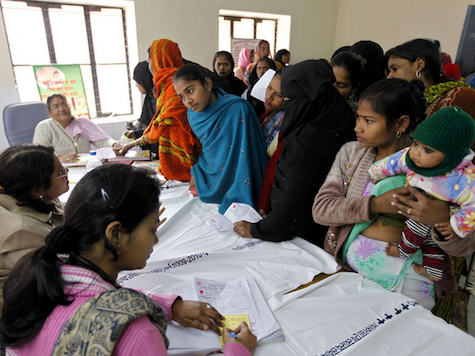
Eight women have just died and 68 other women have been hospitalized because an Indian surgeon used infected instruments in a mass government-sponsored sterilization “camp.” The official limit is 30 such sterilizations per day and scrupulous attention to hygiene.
Clearly, Dr. RK Gupta breached these guidelines. One unnamed official has been quoted as saying: “The doctor failed to disinfect the instruments before using them again.” Further, over 80 women were reportedly operated upon within a five to six hour period in the government-run Nemi Chand hospital in the Pendari area of Bilaspur.
According to Amar Singh Thakur, chief health officer for the Bilaspur district, “The deaths were due to septic shock.” Prime Minister Narendra Modi promised a “thorough investigation and action on this unfortunate tragedy.”
Why does India sterilize women (and men) in such large numbers? That is because the country is suffering from vast overpopulation. In 2011, the census had passed the one billion person mark which makes India second only to China in terms of population. By 2025, India is projected to be the world’s most populous country.
Here’s why. The birth rate remain higher than the death rate; the fertility rate is still very high due to early marriage and the universal practice of marriage. Add to that, poverty, illiteracy, (including illiteracy about or resistance to birth control), the cultural preference for boys—and as many boys as possible (to take care of their aged parents), as well as the illegal migration from Bangladesh and Nepal—and India has a major problem to solve. Overpopulation also taxes the economy and leads to unemployment as well as the overutilization of resources such as land areas, water, forests, etc.
The Indian government chose to deal with this crisis by offering families money if they elected vasectomies or tubectomies. Hence—sterilization camps. Interestingly, in 1952, India was the world’s first country to start a family planning program.
Women tend to suffer the most from efforts to control population growth and are lured to participate in one-day sterilization drives. According to the United Nations, India has the world’s third-highest female sterilization rate after the Dominican Republic and Puerto Rico.
Speaking to Bloomberg News, Kerry McBroom, director of the Reproductive Rights Initiative at the New Delhi-based Human Rights Law Network, argues that what happened at the Nemi Chand hospital is due to “no accountability in the system. The most appalling and terrifying thing is that it is so commonplace in India for women to suffer these surgeries” under poor conditions.
In 2012, Human Rights Watch charged that the use of “numerical targets” (in terms of patients sterilized) contributed to a “coercive environment.” In other words, district health workers are threatened with salary cuts or dismissals if local targets are not met.” To the extent to which women are under-valued and male children over-valued—by both men and women; and the extent to which women are only valued for their child-rearing capacity—little will change.
Five women remain in critical condition after the sterilization surgeries. Eight families are grieving the loss of their wives, mothers, daughters, and sisters.

COMMENTS
Please let us know if you're having issues with commenting.